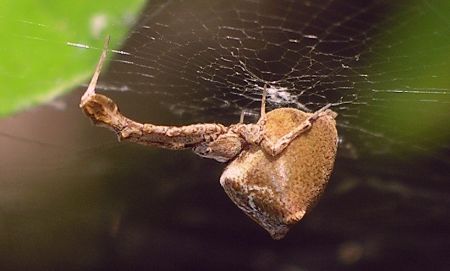by Valerie
March, 2017Feather-legged Orbweaver
It is a well-known fact that almost all spiders have venom glands, which is why any species large enough to puncture human skin can give a rather painful bite in self-defense. The feather-legged orbweaver (Uloborus glomosus), however, belongs to the single family that makes that qualifier about the venom necessary. These spiders have no venom glands in their chelicerae. It's sort of hard to imagine just how anyone figured that out since they are so small that they couldn't give a significant bite anyway. The family contains many more species in the tropics, but in our area there are just a few, with this one being extremely common. It is a very small spider (usually around 5mm or less) and its tiny horizontal webs are easily overlooked. Most spiders that catch their prey in a web wrap it with silk and deliver a fatal bite. Once the victim is dead, the spider can settle down to the long task of liquefying and slurping it up. Feather-legged orbweavers do the wrapping part, but then they just spit up digestive juices onto their meal, wetting it without biting, so death does not come quickly as the insect slowly suffocates. I actually had the chance to check this out. While I was photographing a small plant bug on our back porch, it flew away, becoming entangled in a Uloborus web, where the spider promptly wrapped it up. I looked at my photos on the computer and wasn't satisfied with the quality, so I went back out, took the bug out of the web and carefully unwrapped it. Sure enough, it was still alive and acting pretty normal, so I took more shots. I got better photos, the insect gained a reprieve, but the spider lost that meal. |